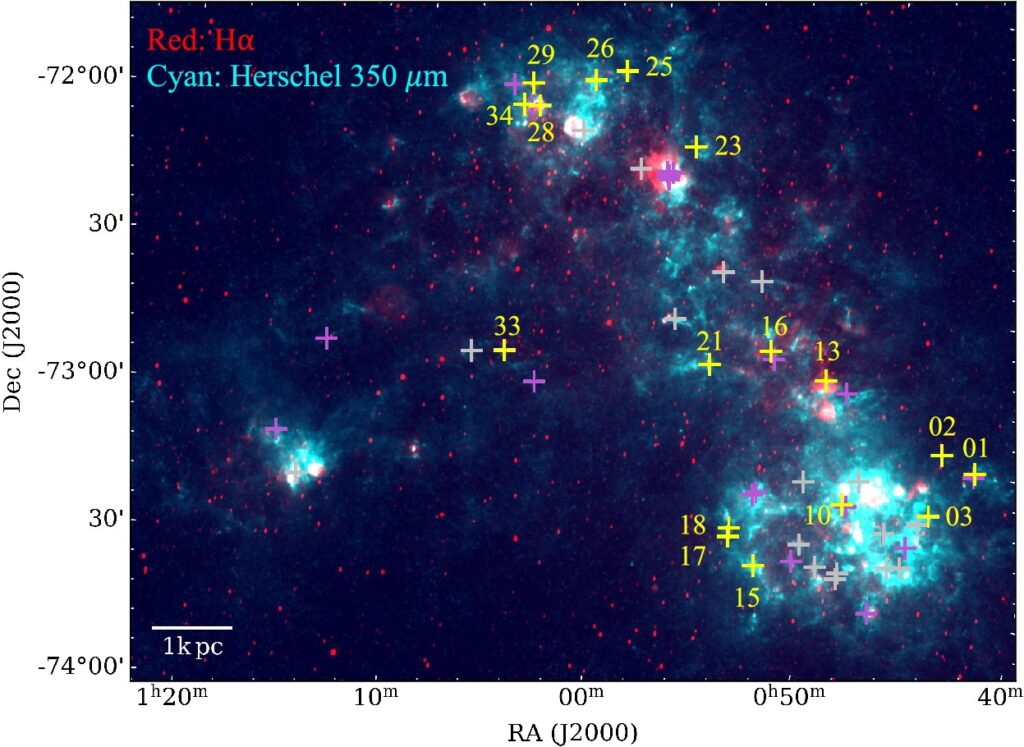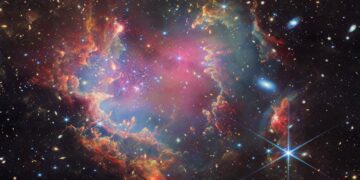Imagine peering back billions of years to witness the universe’s first stars flicker into existence. While time travel remains in the realm of science fiction, astronomers have found the next best thing—a cosmic laboratory that offers a glimpse into the universe’s earliest days. Recent research from Kyushu University and the National Astronomical Observatory of Japan has unveiled a groundbreaking discovery: unique molecular cloud structures in the Small Magellanic Cloud (SMC) that could change everything we know about star formation in the early universe.
The Small Magellanic Cloud: A Glimpse into the Early Universe
The Small Magellanic Cloud is not just another celestial neighbor—it’s a cosmic relic. Located about 200,000 light-years from Earth, this dwarf galaxy contains only about one-fifth of the heavy elements found in the Milky Way, making it an ideal proxy for conditions similar to those in the early universe.

In the early universe, metallicity—the abundance of elements heavier than hydrogen and helium—was incredibly low. Metals play a vital role in cooling gas clouds, allowing them to collapse under their own gravity and form stars. The SMC’s composition closely mirrors that ancient, metal-poor environment, allowing astronomers to study what star formation might have looked like more than 10 billion years ago.
How Stars Are Born: The Role of Molecular Clouds
Stars are not born in isolation; they emerge from vast cosmic nurseries known as Giant Molecular Clouds (GMCs)—enormous regions of gas and dust where gravity molds the raw material of the universe into brilliant, glowing stars. In our own Milky Way, these molecular clouds usually exhibit a filamentary structure, resembling long, string-like threads of gas that collapse into smaller cores where stars begin to form.
But is this filamentary structure a universal feature of star formation throughout cosmic history? This question has intrigued astronomers for decades, and the answer seemed elusive—until now.
Revealing the Unexpected: Fluffy Molecular Clouds in the SMC
Using the powerful vision of the ALMA telescope, scientists observed 17 molecular clouds within the SMC, all associated with young stellar objects (YSOs) up to 20 times the mass of our Sun. The results were both thrilling and surprising: while 60% of the molecular clouds had the familiar filamentary structure seen in the Milky Way, a remarkable 40% had a completely different form—what researchers are calling fluffy clouds.
These fluffy clouds don’t exhibit the elongated, string-like shapes typical of star-forming regions in our galaxy. Instead, they appear more amorphous and irregular, challenging previous assumptions about the universality of filamentary structures in star formation.
The discovery suggests that star formation in the early universe may have occurred in more varied and complex environments than previously thought.
Temperature Tells a Tale: The Evolution of Cloud Structures
One of the most fascinating aspects of this discovery is the significant temperature difference between filamentary and fluffy molecular clouds. Filamentary clouds tend to be hotter, likely due to recent cloud-to-cloud collisions that compress and heat the gas, creating turbulent environments where star formation thrives.
In contrast, fluffy clouds are cooler and less turbulent. Researchers believe that as molecular clouds age, they lose energy and become more stable. This cooling process allows turbulence to smooth out the filamentary structures, leading to the formation of these fluffy shapes.
This finding has profound implications for understanding the evolution of molecular clouds. It suggests that temperature and turbulence play crucial roles in shaping the structure of star-forming regions, potentially determining the types of stars and planetary systems that emerge.
Why This Discovery Matters: Clues to the Early Universe’s Secrets
So, why is the discovery of fluffy molecular clouds in the SMC such a big deal? The answer lies in what it reveals about the universe’s earliest moments.
In low-metallicity environments like those found in the early universe, molecular clouds may have struggled to maintain the filamentary structures necessary for forming low-mass stars and planetary systems like our own. If fluffy clouds were more common billions of years ago, the conditions for forming stars similar to the Sun might have been much rarer.
This could help explain why the early universe was dominated by massive stars that burned brightly and died young, seeding space with the heavy elements necessary for future generations of stars and planets. Understanding these processes helps scientists piece together the puzzle of cosmic evolution and the origins of galaxies, stars, and even life itself.
What’s Next for Star Formation Research?
The discovery of fluffy molecular clouds is just the beginning. Future studies will dive deeper into how these clouds form, evolve, and influence star formation in different galactic environments. Scientists aim to compare these findings with observations of higher-metallicity galaxies, like the Milky Way, to understand how heavy elements shape the evolution of molecular clouds.
Upcoming missions using the James Webb Space Telescope (JWST) and advanced ground-based observatories will allow researchers to probe these molecular clouds in unprecedented detail. Questions about how magnetic fields, turbulence, and radiative feedback from young stars influence molecular cloud structures are already at the forefront of astrophysical research.
Conclusion: A New Chapter in Understanding Our Cosmic Origins
The discovery of fluffy molecular clouds in the Small Magellanic Cloud offers an exciting new perspective on how stars formed in the early universe. By revealing that molecular clouds can take on diverse shapes depending on their age, temperature, and environment, this research challenges long-held assumptions about the universality of star formation.
Reference:



















